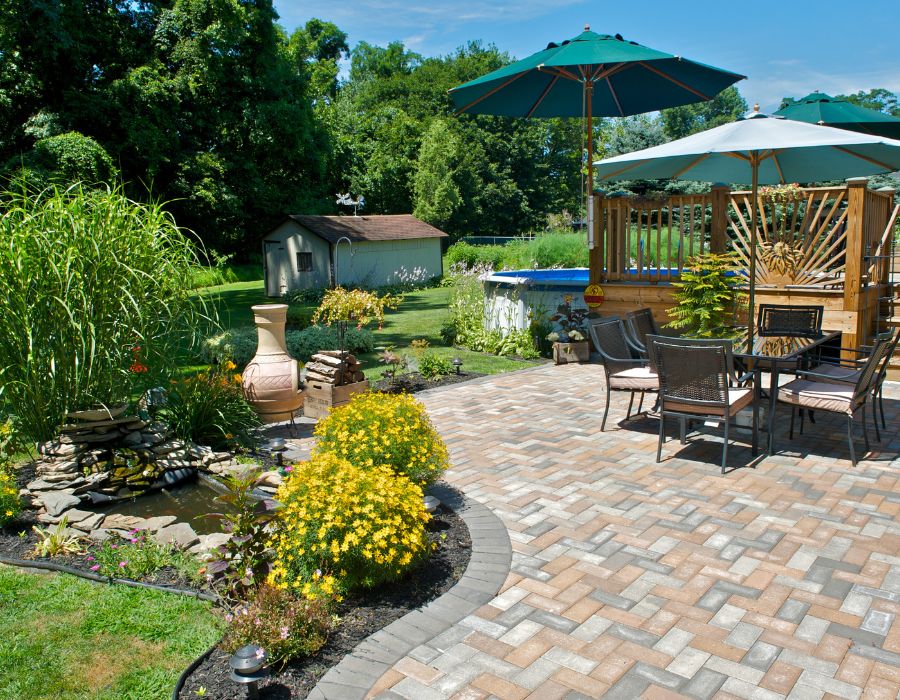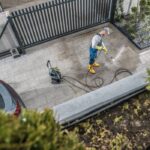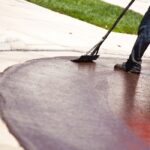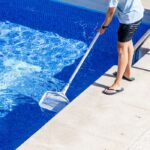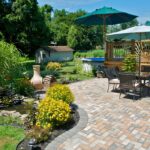A decorative concrete patio is a stunning addition to any home, offering durability and aesthetic appeal. However, maintaining its beauty and functionality requires proper care, especially in San Antonio’s unique climate, which includes intense heat, humidity, and occasional storms. Let us explore decorative concrete patio maintenance, including concrete sealing tips, protective coatings, patio cleaning methods, and ways to handle San Antonio weather conditions effectively.
Understanding San Antonio’s Weather and Its Effects on Decorative Concrete
San Antonio’s climate is characterized by hot summers, occasional freezing temperatures in winter, and high humidity levels. These conditions can significantly impact the longevity and appearance of your concrete patio. Some key challenges include:
- UV Exposure: Prolonged sunlight can cause color fading in stained concrete and weaken sealants over time.
- Temperature Fluctuations: Extreme heat and occasional cold snaps can cause expansion and contraction, leading to cracks.
- Humidity and Rain: Moisture retention can promote mold and mildew growth, leading to surface discoloration.
- Dust and Debris: Wind-blown debris and dirt can accumulate, dulling the surface’s shine and making it slippery.
Proper seasonal care can help mitigate these effects and extend the longevity of concrete surfaces.
Essential Decorative Concrete Patio Maintenance Steps
1. Regular Cleaning: Preventing Dirt Buildup and Mildew Growth
Keeping your patio clean prevents debris buildup and reduces the risk of mold and mildew growth in humid conditions. Follow these patio cleaning methods:
Weekly Maintenance:
- Sweep the surface using a soft-bristle broom or a leaf blower to remove dust, leaves, and debris.
- Rinse the patio with a garden hose to prevent dirt from settling into cracks or textured surfaces to prevent mold and mildew prevention.
Monthly Deep Cleaning:
- Use a pH-neutral cleaner mixed with water to mop the surface. Avoid harsh chemicals like ammonia or bleach, which can break down protective coatings.
- For stubborn stains, a mixture of mild detergent and warm water can help lift grime without damaging the concrete.
Dealing with Mold and Mildew:
- Mix one part white vinegar with three parts water and gently scrub the affected area using a soft brush.
- Ensure proper drainage to prevent water pooling, which encourages mildew growth.
2. Concrete Sealing Tips: Protecting Against Weather Damage
Applying a high-quality concrete sealer is one of the most effective ways to enhance your patio’s resilience against San Antonio weather conditions. Sealing prevents moisture absorption, fading, and surface wear.
How Often Should You Reseal Your Concrete Patio?
- Every 2–3 years for high-traffic areas or if your patio is frequently exposed to harsh weather.
- Every 4–5 years for patios in shaded areas with minimal foot traffic.
Choosing the Right Sealer:
- Acrylic sealers: Ideal for enhancing color and providing a glossy finish, but require more frequent reapplication.
- Penetrating sealers: Best for long-term protection against moisture and stains without altering the patio’s natural appearance.
- Polyurethane or epoxy sealers: Provide heavy-duty protection, especially for patios with outdoor furniture or heavy usage.
3. Protective Coatings: Preventing Damage from UV Rays and Wear
In addition to sealing, applying protective coatings can further safeguard your patio against UV protection, temperature fluctuations, and daily wear and tear.
Benefits of Protective Coatings:
- Protects against sunlight exposure, reducing fading of stained or stamped concrete.
- Creates a non-slip surface to enhance safety during rainy or humid conditions.
- Adds an extra layer of durability, preventing cracks and scratches from furniture or foot traffic.
Best Protective Coatings for Decorative Concrete:
- UV-resistant sealers: Ideal for stained concrete patios exposed to direct sunlight.
- Slip-resistant coatings: Recommended for poolside patios or areas prone to moisture buildup.
- Epoxy coatings: Best for heavy-use patios requiring a robust protective layer.
4. Handling Cracks and Repairs: Addressing Damage Early
Even with the best maintenance, temperature fluctuations and wear can cause minor cracks. Addressing these early prevents further deterioration.
How to Fix Small Cracks:
- Clean the crack thoroughly with a wire brush and water.
- Apply a concrete patching compound that matches the patio’s color and texture.
- Allow the repair to cure completely before resealing the area for added protection.
When to Call a Professional:
- If cracks are wider than 1/8 inch, indicating structural movement.
- If large areas of the patio have surface flaking or discoloration beyond DIY repair.
5. Seasonal Care: Adjusting Maintenance for San Antonio’s Climate
Each season presents different challenges for your decorative concrete patio maintenance. Adjusting your care routine based on the time of year ensures lasting durability.
Spring & Summer:
- Apply a fresh coat of sealer before peak sun exposure.
- Keep furniture with rubber feet to prevent scratches and heat-related damage.
- Hose down the patio frequently to remove dust and pollen.
Fall & Winter:
- Remove leaves and organic debris promptly to prevent staining.
- Cover furniture legs with felt pads to minimize surface wear.
- Avoid using de-icing salts if rare cold snaps occur, as they can damage the concrete surface.
FAQs About Decorative Concrete Patio Maintenance
1. How often should I reseal my decorative concrete patio?
- Every 2–3 years for patios exposed to high foot traffic and direct sunlight.
- Every 4–5 years for shaded patios or areas with minimal exposure to harsh weather.
2. What cleaning products are safe to use on stamped or stained concrete?
- Use pH-neutral cleaners and mild detergents diluted with water.
- Avoid harsh chemicals like bleach, ammonia, or acid-based solutions, which can degrade sealers and color treatments.
3. How does San Antonio’s hot climate affect my concrete patio?
- Intense UV rays can fade colors if the patio is not properly sealed.
- Temperature fluctuations can cause expansion and contraction, leading to cracks.
- High humidity increases the risk of mold and mildew growth, especially in shaded areas.
4. Can I pressure wash my decorative concrete without causing damage?
- Yes, but use a low-pressure setting (1,500–2,500 PSI) and a fan spray nozzle to avoid surface damage.
- Avoid holding the spray in one spot for too long to prevent etching or sealant removal.
Final Thoughts: Keeping Your Concrete Patio in Top Condition
Maintaining a decorative concrete patio in San Antonio’s climate requires regular cleaning, sealing, and protective measures to counteract the effects of UV exposure, humidity, and temperature fluctuations. By following proper decorative concrete patio maintenance techniques, you can preserve its beauty, functionality, and longevity for years to come.

